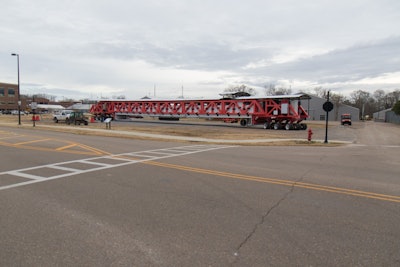
A giant machine that is 150 feet long, 14 feet tall, 15 feet wide and weighs 125 tons was recently delivered to the U.S. Army by Dynatest.
The Danish-American company headquartered in Copenhagen, Denmark, has manufactured equipment and software to evaluate runways and roads for more than 46 years.
“There is no doubt that we are ‘nerds’ in our field,” says Jesper Rantala, CEO of Dynatest. “We have a strong focus on improving details and further developing our equipment.”
Two years were spent developing the heavy vehicle simulator, nicknamed the “Titan,” which the military will use to ensure durable runways for military aircraft in the United States.
“When the giant C17 military aircraft lands, enormous forces hit the ground,” says Jesper Rantala, CEO of Dynatest. “This requires a runway built for that purpose. When it comes to U.S. defense equipment, nothing is left to chance. Everything is thoroughly tested. This also applies to the pavement on the runways that the defense has at its disposal,”
Reportedly the largest vehicle of its kinds, the Titan is now up and running at the military base in Vicksburg, Mississippi, where the U.S. Army Development Department, U.S. Army Engineer Research and Development Center will be using it in its research.
“The heavy-vehicle simulator Titan, built in partnership with Dynatest, is a critical research tool to evaluate new materials, design methods and construction techniques to optimize transportation infrastructure facilities,” says Jeb Tingle, senior scientific technical manager at the U.S. Army Engineer Research and Development Center’s Geotechnical and Structural Laboratory. “It has been a long process to get us where we are today, and with this new capability added to the ERDC toolkit, we will be able to discover, develop and deliver solutions to the warfighter and nation much more quickly.”
He notes that the Titan can apply a dynamic impact load to simulate impact loadings from aircraft touchdown and vertical takeoff and landing aircraft.
“No other heavy vehicle simulator is capable of performing these critical tests,” Tingle says. “The Titan also has some first-of-their-kind features to help ERDC support military transportation needs.”
With a wheel that goes back and forth, the task of the heavy vehicle simulator is to imitate the forces of a military aircraft and thereby test the strength of the runway.
“It is not possible to determine whether a runway is worn out just by looking at the surface,” Rantala says.
Pavement consists of several layers, all of which must be in good condition to ensure that the load-bearing capacity is strong enough. He says with the heavy-vehicle simulator, you can test how 20 years of use affects the pavement in just three months.
“It provides an accurate and realistic picture of the condition of the runway, and in this way, you get the opportunity to develop better runways,” Rantala says.
Titan quick specs
- Weight: 125 tons
- Length: 150 feet
- Width: 16 feet
- Height: 17.5 feet
 Dyantest
Dyantest











